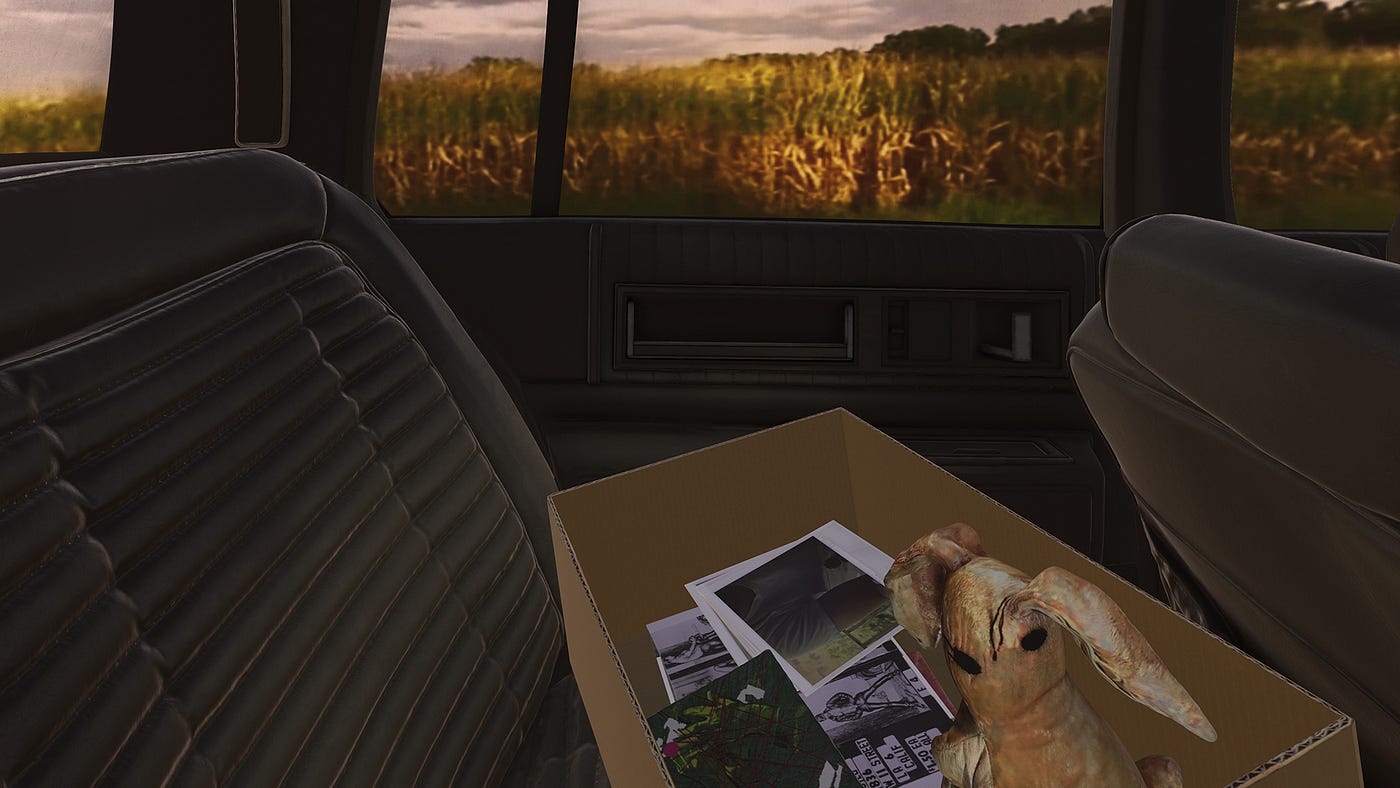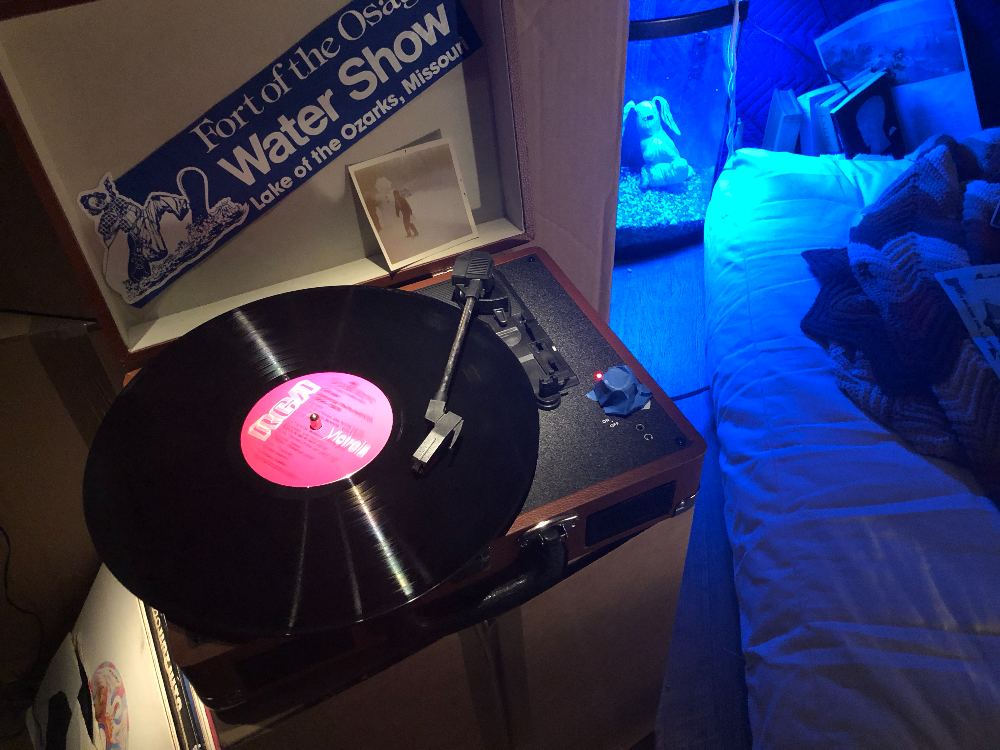HIV/AIDS in the early ’90s, in ‘Queerskins: a love story’
I’m in a cramped attic bedroom formerly occupied by Sebastian Adler. It’s a painstakingly accurate recreation of a young adult’s bedroom in the ’90s. The bed is a mattress on the floor with a pile of books, newspapers, and photos on top of it. I see a typewriter on the bed with a page still stuck in it, half-finished. There’s also a turntable playing something beautiful. It’s classical music, I think. I crane my neck to read the spinning vinyl, but it’s difficult to read the label. I look down to see the front page of the LA Times; it announces that Magic Johnson has revealed to the world that he is HIV-positive. But somehow this room feels like a respite from the rest of the world and a place for quiet contemplation. It’s wonderful.
“Don’t miss the closet,” whispers one of the creators. “You can stay as long as you like and you can touch everything.”
I walk into the next room and am surprised to see faux sunlight streaming in through two windows. I see two VR setups facing the wall, currently occupied by two other people. And on the other side of the room, I spy a dresser and bookshelf filled with personal possessions. Someone has written the words “so let us pray to God so that we may be free of God” in red lipstick on the mirror on the dresser. I see a leather-bound journal cracked open so I start to flip through the pages but think better of it. I turn to the bookshelf where a Walkman catches my eye. I pick it up, place one of the blue rubber earbuds into my right ear, and hit play. The button makes a satisfying click. To my surprise, the cassette plays, and I hear a woman talking.

But one of the other attendees gets up to leave, so I quickly fumble around to find the stop button. I sit down and brace myself for what’s to come in this story, having spent several minutes exploring Sebastian’s world by rifling through his belongings. And I can tell this one’s going to be a doozy.
This small series of rooms has been created in support of the VR version of Queerskins: a love story (which is also an online multimedia novel). The story is based around a grieving family where the two devoutly Catholic and estranged parents, Ed and Mary-Helen, have come into possession of a box of items belonging to their deceased son. Sebastian, a gay physician, has died of AIDS. It’s the early ’90s, the start of the AIDS epidemic.

After I’m strapped into the headset, I find myself seated in the back seat of Sebastian’s parents’ vintage 1986 Cadillac Sedan Deville, as they drive somewhere in silence. I begin to suspect that I’m Sebastian’s ghost. We’re on a long country road in the middle of nowhere, Missouri. As his father fiddles with the radio, I feel the hum of the engine vibrating underneath my seat. He compliments her dress. His mother is trying not to cry, but it seems like she might lash out at any moment. I can see the bags under her eyes.
They sit in heavy silence, and I notice there’s a box next to me in the back seat. It’s full of Sebastian’s belongings. I start to recognize some of the items in the box as ones from the lovingly crafted room from before: a Halloween mask, paperback books, and more. I awkwardly rummage around as Ed and Mary-Helen begin to have a complicated argument about their son: his sins, his queerness, their lack of forgiveness, and their abandonment in his time of need. And it’s heartbreaking to hear the two parents struggle to reconcile their strong religious beliefs with their son’s sexuality, while they also come to terms with his death at such a young age. The pain they’re both feeling is thick in the air. It takes my breath away.
Queerskins feels like a VR relative of Gone Home (with more than a few subject matter similarities) crossed with a gut-wrenching car play. As the participant enters the physical space, they get to know Sebastian through the things he left behind. These same objects help control the narrative in the virtual experience as the parents continue their drive. From the backseat of the car, it’s almost physically painful to witness Sebastian’s parents go through their grief. Despite its intensity, the VR section seems like it’s over far too soon. I am left to wonder what is going to happen next between Ed — who continues to call Sebastian a disgrace — and Mary-Helen — who believes in her heart of hearts that Sebastian repented for his sins. (I’m told the creators have a few more chapters planned.)

Queerskins works as wonderfully as both an intimate VR piece, but also as a lovingly-designed, built environment. The physical space draws the viewer into the story world and serves as a bridge between the virtual world and the tactile, each side enhancing the other and deepening the meaning of both. I sincerely hope the creators continue telling the story of the Adler family in the same emotionally resonant, tenderly crafted fashion in the future.
Queerskins: a love story continues at the Tribeca Film Festival’s Virtual Arcade through April 28. Tickets are $40 for each 3 hour time slot. Capacity is limited and many exhibits will have long waits; it is suggested that visitors arrive 30+ minutes early before each session.
Catch up on all of our Tribeca Immersive 2018 diary entries.
No Proscenium is made possible by people like you: join us on Patreon today to support more content like this.
In addition to the No Proscenium website, our podcast, and our newsletters, you can find NoPro on Twitter, Facebook, YouTube, Instagram, in our online community Everything Immersive and in our Slack forum.




















Discussion